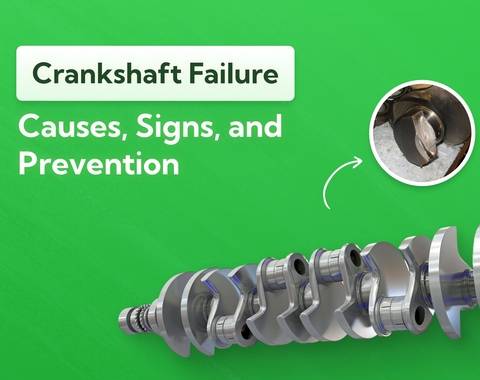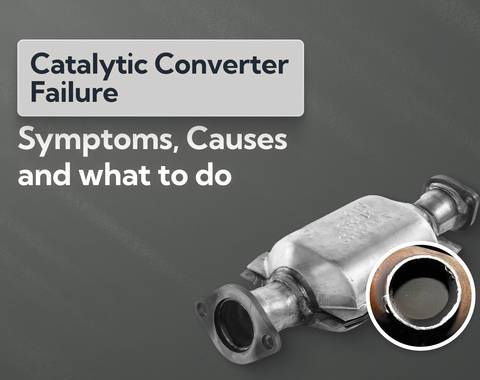Head Gasket Failure: Causes, Symptoms and Fixes
A blown head gasket can turn a healthy engine into an expensive repair fast. Learn how to spot the warning signs early, understand what causes gasket failure and discover whether repair, replacement or scrapping your car makes the most sense, plus simple ways to prevent it from happening again.
Last updated: 16th October, 2025

Award-winning CEO driving growth and social impact across automotive, recycling, and technology-led enterprise platforms.

Listen to this story
The head gasket might be small, but it plays a critical role in your car’s engine. It sits between the engine block and the cylinder head, sealing in the pressure needed for combustion and keeping oil and coolant where they belong.
In simple terms, it keeps the different parts of your engine working together without leaking into each other. It stops engine pressure from escaping, and makes sure coolant and oil don’t mix (which would lead to overheating, engine damage or complete engine failure).
Because of that, knowing how to spot head gasket problems early can save you from a major repair bill or even a completely ruined engine.
In this article, we’ll cover what causes head gasket failure, how to spot the signs early, your repair options and how to help prevent it from happening in the first place.
What's in this article
- 3. Incorrect installation
- 4. What are the symptoms of a blown head gasket?
- 4.1 White smoke from the exhaust
- 4.2 Bubbling in the coolant reservoir
- 4.3 Coolant loss with no visible leaks
- 4.4 Milky oil
- 4.5 Engine overheating
- 4.6 How much does it cost to repair or replace a blown head gasket?
- 4.7 Average repair costs
- 4.8 Avg. head gasket repair and replacement cost by model
- 4.9 Factors affecting repair costs
- 4.10 Repair vs replacement costs
- 5. Should I repair or scrap my car with a blown head gasket?
- 6. What is a head gasket sealer?
- 7. Tips to prevent head gasket failure
What is a head gasket?
The head gasket is a thin but tough seal that sits between the engine block (the lower part of the engine) and the cylinder head (the upper part). Its main job is to seal everything in tightly so the engine can run properly.
It keeps the combustion chamber sealed, so your engine holds the pressure it needs to fire each cylinder. At the same time, it prevents coolant, engine oil and exhaust gases from leaking into each other or into parts of the engine where they don’t belong.
That means no coolant in the oil, no oil in the cylinders and no exhaust gases escaping where they shouldn’t. It’s a critical component because it keeps all three systems (combustion, cooling and lubrication) separate and under control.
When it goes, so does your engine’s ability to function normally.
What does a head gasket do?
The head gasket’s job is to manage some of the toughest conditions inside your engine: extreme heat, pressure and constant movement.
First, it seals the combustion chamber so each ignition cycle builds full pressure without leaking. That pressure is what drives the pistons and gives your car power. So if it escapes, performance takes a massive hit.
It also acts as a barrier between the oil and coolant channels. These fluids pass through the engine in close proximity, but they serve completely different purposes. If they mix, it can seriously damage your engine. The head gasket is what keeps them apart.
On top of all that, it transfers heat evenly between the engine block and cylinder head. Without it, uneven heat causes metal parts to expand and warp, which leads to cracks, leaks and expensive under-the-bonnet repairs.
What are the common causes of head gasket failure?
Head gasket failure usually comes down to a mix of heat, pressure, and time.
Overheating is one of the biggest culprits because high temperatures warp engine parts and break the seal. Excessive engine pressure puts extra strain on the gasket, especially under hard driving. Sometimes the problem starts with poor-quality materials or a faulty installation. And like any component, even a good gasket can simply wear out over time.
Overheating
When engine temperatures climb too high, the metal parts of the engine can expand and warp, including the surfaces the gasket is meant to seal. This creates gaps, weakens the gasket’s hold and eventually leads to cracking or complete failure.
Common reasons your engine might overheat include:
- Coolant leaks
- A broken water pump
- A stuck thermostat
- A failing radiator
Even something as simple as low coolant levels can cause serious heat buildup if ignored, which is precisely why keeping your cooling system in good condition is so important. Regular checks, timely coolant top-ups and quick repairs when leaks appear all help you prevent the kind of heat damage that ruins head gaskets.
High engine pressure
The head gasket’s job is to contain the intense pressure created during combustion, but when that pressure gets too high, it pushes the gasket beyond its limits. Think of it like an overinflated tyre: too much internal force and something will eventually give.
Engines with turbochargers or superchargers are especially prone to this. These systems force more air into the cylinders to increase power, which also increases combustion pressure. Without proper tuning or if components start to wear, that extra stress can blow the gasket.
Engine misfires can also cause sudden pressure spikes. If fuel ignites at the wrong time, it sends shockwaves through the engine, hammering the gasket in ways it wasn’t designed to handle.
Poor-quality gasket material
Since head gaskets need to handle extreme heat and pressure, the material matters. A lot. High-quality gaskets are typically made from multi-layer steel (MLS), which offers strength, heat resistance and long-term durability.
Cheaper gaskets occasionally use composite materials like graphite, which degrade faster, particularly in high-performance or turbocharged engines.
In our experience, using a substandard or incompatible gasket almost always leads to early failure. That’s why we always recommend sticking with high-quality OEM parts that are designed for your specific engine, even if they’re a bit on the pricier side.
Incorrect installation
The gasket needs to sit perfectly flat between the engine block and cylinder head. If it’s misaligned or the bolts aren’t tightened to the right torque, it won’t seal correctly. It’s like putting a lid on a pan without lining it up. Pressure and fluid are going to find a way out.
This is why you have to follow the manufacturer’s torque settings and tightening sequence. These engines are finely engineered and even slight deviations during installation lead to warping, leaks and premature failure.
Reusing old gaskets and cleaning them poorly are two other mistakes I see quite a bit. Once compressed, they can’t seal the same way again. And if the mating surfaces aren’t properly cleaned before fitting a new gasket, leftover debris or residue create gaps that cause leaks.
Wear and tear over time
In most cases, a head gasket can last up to 200,000 miles (which lines up with the expected lifespan of the engine itself). But that depends heavily on how the car is driven and maintained. Regular short trips, overheating and poor maintenance all shorten its life.
Regardless, years of heat, pressure and vibration slowly break down its ability to hold a perfect seal. And as the gasket ages, it may become brittle, lose its elasticity or develop small cracks. This is why older vehicles are more prone to head gasket failure.
What are the symptoms of a blown head gasket?
If your head gasket blows, your car’s going to let you know. It’s just that the signs aren’t always obvious at first. You might see white smoke from the exhaust, notice your coolant bubbling in the reservoir or disappearing or find milky sludge under the oil cap. Maybe the engine starts overheating or just doesn’t feel right when you drive.
Each of these symptoms points to a breakdown in the seal between vital systems in the engine.
Problem is, these issues start small but quickly turn into a full engine failure. That’s why it’s critical to recognise the warning signs before the damage gets worse.
White smoke from the exhaust
If you see thick white smoke pouring from your exhaust, particularly after the engine warms up, it normally means coolant is leaking into the combustion chamber and being burned along with the air-fuel mixture. That doesn’t happen under normal conditions.
It’s one of the most common and visible symptoms of a blown head gasket because the leak allows coolant to seep past the seal and into the cylinders. When it burns, it turns into steam, which exits through the exhaust and looks like white smoke.
Burning coolant reduces engine efficiency, causes rough running and increases your car’s emissions. Over time, it’ll damage the catalytic converter and cause overheating as your coolant level drops.
Bubbling in the coolant reservoir
If you notice bubbling or frothing in the coolant reservoir, it could mean combustion gases are leaking into the cooling system. This happens when a blown head gasket lets pressure from the cylinders escape into the coolant passages.
That extra gas disrupts normal coolant flow and reduces the system’s ability to regulate engine temperature. Over time, it can cause overheating, poor circulation, and even damage to the radiator or hoses.
If you see bubbles rising in the tank while the engine is running, take it to the garage ASAP. It’s a strong sign something’s wrong internally, and diagnosing it early will save you from a much bigger repair later.
Coolant loss with no visible leaks
A blown head gasket allows coolant to seep into the combustion chamber, where it gets burned off during engine operation. If you’re constantly topping it up but don’t see any drips or puddles, it’s sign that’s happening.
This kind of leak is tricky because there’s no obvious mess, but the result is the same: low coolant levels and rising engine temperatures. It sometimes leaves deposits inside the cylinders as well, and damages other engine parts over time.
Coolant is supposed to last around 30,000 miles. Monitor the levels periodically. If half is gone in just a few months, you know something’s up.
Milky oil
Check your oil cap or dipstick. If the oil looks milky or creamy like a coffee milkshake, that’s not normal. It means coolant has mixed with engine oil, which is a strong sign the head gasket has failed.
This mixture ruins the oil’s ability to lubricate the engine. Without proper lubrication, internal parts grind, wear out faster and risk serious damage.
Engine overheating
If coolant is leaking into the cylinders or being pushed out of the system by combustion gases, the engine loses its ability to regulate temperature. You’ll usually spot this on the temperature gauge creeping into the red, or via a warning light on the dash. You might also notice the heater blowing cold air, steam from the bonnet or a strange smell coming from the engine bay.
Overheating is never something to ignore. Even short bursts of high temperatures can warp metal components under the bonnet and do serious, irreversible damage to the engine.
How much does it cost to repair or replace a blown head gasket?
Depending on your car, head gasket repair costs range from several hundred to several thousand pounds. In some cases, especially with older or lower-value vehicles, it might make more sense to replace the engine entirely… or even scrap the car.
The total cost depends on several factors: the make and model of your car, where you live, the extent of the damage and whether other parts (like the cylinder head) are also affected.
Average repair costs
Repairing a blown head gasket typically costs between £500 and £1,800 in the UK. The bulk of that expense comes from labour since the mechanic has to dismantle large parts of the engine to reach the gasket itself.
Parts are usually the smaller portion of the bill, but you might also need extra work. Cleaning the cooling system, resurfacing the cylinder head, replacing coolant hoses, fitting a new thermostat and changing the engine oil and filter are all things that increase your final bill.
Costs can vary depending on the make and model of your car, as well as your location. A small hatchback falls on the lower end of the range than a performance or premium model, which is easily double thanks to more complex engines and pricier components.
Avg. head gasket repair and replacement cost by model
| Manufacturer | Cost range / estimate | Typical labour hours |
|---|---|---|
| Audi | £800 to £1,500 | 8 to 20+ hours |
| BMW | £800 to £1,500 | 8 to 20+ hours |
| Ford | £500 to £1,200 | 6 to 12+ hours |
| Honda | £600 to £1,300 | 6 to 10 hours |
| Land Rover | £1,200 to £2,500 | 10 to 20 hours |
| Mercedes-Benz | £1,000 to £2,000 | 8 to 20+ hours |
| Nissan | £400 to £1,000 | 6 to 10 hours |
| Toyota | £400 to £1,000 | 5 to 10 hours |
| Vauxhall | £500 to £1,200 | 5 to 10 hours |
| Volkswagen | £600 to £1,300 | 5 to 10 hours |
| All makes (overall) | £500 to £1,800 | 5 to 10 hours; up to 30 hours for V-shape/boxer configurations and additional work required |
Factors affecting repair costs
The price of a head gasket repair depends on four key factors:
- Vehicle type: Cars with complex or tight engine bays (e.g. BMWs, Audis, turbocharged and performance models) take longer to work on, which drives up labour costs.
- Engine layout: Some engines, like Subaru’s boxer engines or mid-engine setups in older Toyotas and Hondas, are notoriously tricky to access. If the mechanic has to remove timing components or engine mounts to reach the gasket, it’s going to cost more.
- Parts availability: Rare, classic and imported models are expensive to source parts for and delays add to labour costs.
- Location: Labour rates vary across the UK. Central London and Manchester garages usually charge much more per hour than smaller towns or rural areas.
Even two similar cars can have very different repair bills based on these factors.
Repair vs replacement costs
If the repair quote approaches or exceeds your car’s value, replacing the engine sometimes makes more sense.
A replacement engine costs anywhere from £1,500 to £8,000 depending on the make, age and whether it’s new, reconditioned or used. While it’s a larger upfront cost, it does give you peace of mind if the rest of the car is in good shape.
However, if the vehicle is old or has other issues, you could be throwing good money after bad. Always consider long-term maintenance costs and how much life the car realistically has left.
Should I repair or scrap my car with a blown head gasket?
A blown head gasket puts you at a crossroads: do you fix the problem, or cut your losses? The right choice depends on your car’s age, condition and value as well as how much the repair will cost compared to what the vehicle is actually worth.
If your car is relatively new and in otherwise good condition, repairing it makes sense. But if it’s older, high mileage or worth less than the repair itself, the more practical (not to mention less stressful) option is to scrap your car.
When to repair
Repairing a blown head gasket can be worthwhile if:
- Your car is less than 15 years old and in generally good shape.
- The repair cost is less than 50% of the car’s value (we always follow the “50% Rule”).
- The engine hasn’t suffered additional damage (like a cracked cylinder head).
- You plan to keep the car long-term, making the investment worthwhile.
- The vehicle has sentimental or resale value once fixed.
It really comes down to long-term reliability versus long-term costs. If repairing the car doesn’t require multiple different fixes and gets you several years of useful life out of it, it’s a good deal.
When to scrap
Scrapping your car becomes the better choice when:
- The repair cost exceeds 50% of the car’s value.
- The engine has severe internal damage.
- The car is 15+ years old and/or has 100,000+ miles.
- You’re facing multiple upcoming repairs in addition to the head gasket.
If your car fits any of these, repairing it only postpones the inevitable. Scrapping is a cleaner exit that saves you ongoing costs and future breakdowns. Plus, licensed scrapyards will recycle the materials responsibly and pay you for the car’s scrap value (plus reusable parts if you scrap through Car.co.uk).
What the experts say

Steven Jackson OBE
Environmental and financial considerations
Both repair and scrapping have trade-offs:
- Environmental impact: Repairing extends your car’s lifespan, reducing waste and the need for new manufacturing. Scrapping allows materials like steel and aluminium to be recycled responsibly.
- Financial impact: Repairing is cheaper short-term if your car still has good life left in it. But if you’re constantly fixing one thing after another, scrapping saves you thousands in long-term maintenance.
- Resale and replacement: A successfully repaired car holds its value better when it meets the other criteria, while scrapping gets you an immediate payout you can put toward a newer and more reliable vehicle.
Moral of the story is: Repair if your car has life left. Scrap if it’s just hanging on.
What is a head gasket sealer?
Head gasket sealer is a chemical solution that temporarily seals small leaks in the head gasket. It works by circulating through the cooling system, finding the weak spot and hardening when exposed to heat and pressure to close off minor cracks or gaps.
Sealants are useful as a short-term fix if you’re dealing with a mild leak or need to keep the car running until a mechanic can do a proper repair. But they aren’t a permanent solution because they can’t restore a gasket that’s severely damaged or completely blown.
How does head gasket sealer work?
Head gasket sealers use sodium silicate (often called liquid glass) along with micro-fibres, ceramic particles or polymers that react to heat and pressure.
As the engine warms up, the sealer circulates through the cooling system and is drawn toward areas where coolant or gases are escaping. When it reaches those hot spots, the sodium silicate crystallises and hardens, creating a temporary seal over small cracks or gaps.
Here’s how the process typically works:
- Let the engine cool completely before starting.
- Drain or top up the coolant as directed on the product label.
- Shake and pour the sealer into the radiator or coolant reservoir.
- Start the engine and let it idle until it reaches operating temperature so the sealer can circulate.
- Allow it to cool again before topping up and driving normally.
Over time, the seal can still break down or block small coolant passages. So it should always be viewed as a temporary measure, not a cure.
When should you use a head gasket sealer?
You should use head gasket sealer only as a short-term measure until you can arrange a proper head gasket repair in situations like these:
ideally in situations like these:
- The leak is minor and hasn’t yet caused major overheating or oil contamination.
- You need a temporary fix to keep the car running for a short time (for example, to reach a nearby repair garage).
- You’ve already confirmed the problem but can’t afford or schedule a full repair immediately.
- The engine still runs smoothly, with no severe loss of power or compression.
But DON’T use sealers for severe head gasket damage. If coolant and oil have mixed, the engine overheats constantly or compression has already dropped significantly, the sealer won’t help (and using it could make things worse by clogging the cooling system).
If you rely on it as a long-term fix, it’ll create bigger and costlier problems later.
How much does head gasket sealer cost?
Most head gasket sealers in the UK cost between £20 and £60 per bottle depending on the brand, formula, and size of the bottle. Premium products from well-known brands like Steel Seal, K-Seal and BlueDevil sit at the higher end of that range, but you can find cheaper alternatives for under £25.
In my personal experience, price does reflect quality and reliability here. More expensive sealers have stronger chemical compounds (like sodium silicate or advanced polymers) that bond better and last longer. Cheap unknown brands might work briefly but are generally less effective at sealing anything beyond the tiniest leaks.
Even at £60, a bottle of sealer is just ~10% of the cost of even the least expensive full head gasket repair.
What the experts say

Anthony Sharkey
Tips to prevent head gasket failure
While some head gasket failures happen without warning, most can be prevented with consistent care and attention. Regular maintenance checks, timely oil changes and inspections, keeping your cooling system healthy to prevent overheating and using quality parts during repairs all go a long way toward protecting your engine.
We’ll break down a few simple habits and maintenance tips that’ll drastically reduce your chances of a blown head gasket (and save you from expensive repairs later).
Regular maintenance checks
Low coolant leads to overheating and contaminated or low oil increases friction and heat. Yet so many drivers go months without even lifting the bonnet. A quick weekly check will save you from major headaches later.
When inspecting for leaks, look for:
- Puddles or drips under the car (green, pink or orange for coolant; brown or black for oil).
- White residue or staining around hose connections or the radiator.
- Sweet or burnt smells from the engine bay.
- Steam coming from the bonnet after driving.
Routine engine diagnostics are also key. A garage can run pressure tests, coolant system checks, and oil analyses to spot early issues long before they become serious. For this, I’d recommend at least once per year or every 10,000 to 12,000 miles.
Prevent overheating
To keep your engine cool:
- Check your radiator regularly for blockages, leaks and corrosion.
- Test your thermostat if your car overheats or stays cold for too long.
- Flush the radiator every few years (or as your car’s manual recommends) to remove rust, sludge and debris.
- Replace old coolant with the correct type and mixture every ~30,000 miles.
- Inspect coolant hoses for cracks or softness and replace them before they split under pressure.
And while you’re driving, keep an eye on the temperature gauge. If it starts to climb above normal, turn off the air conditioning, switch on the heater to draw heat away from the engine, and pull over safely if it continues to rise.
Use high-quality parts
If there’s one rule to remember when it comes to head gasket longevity, it’s this: never cut corners on parts.
OEM (Original Equipment Manufacturer) parts are built to the exact specifications of your engine. They seal better, handle higher temperatures and resist the constant expansion and contraction that happens every time you drive.
Cheap or unbranded ones use inferior materials that don’t perform as well under stress. They’ll warp, degrade and eventually leak much sooner. Really, it’s about reliability; trying to save a bit on the upfront cost will turn that one-time repair into a recurring expense.
Timely oil changes
Clean oil is the easiest way to protect your head gasket. Over time, engine oil collects dirt, metal particles and sludge that clogs passages and limits its lubricating capabilities. When that happens, friction and heat build up. Those are two things a head gasket hates.
Fresh oil reduces wear on moving parts and helps regulate the temperature. It also prevents carbon buildup around the gasket area, which weakens the seal over time.
As a general rule:
- Petrol engines: Every 7,000 to 10,000 miles or once a year, whichever comes first.
- Diesel engines: Every 5,000 to 7,000 miles or biannually due to heavier soot buildup.
- High-performance and turbo engines: every 4,000 to 5,000 miles, since they run hotter and stress the oil more.
Frequently asked questions
Technically, yes, as in “the car will start”.
That said… I would never recommend driving with a blown head gasket, not even “just for a bit”. I’ve seen engines last a few hundred miles before dying completely, and others fail within a few hundred feet. It’s impossible to predict and the risk simply isn’t worth it.
Professional mechanics are able to confirm a blown head gasket using several methods: compression test (checks for pressure loss in the cylinders), leak-down test (identifies where the pressure is escaping), chemical test (detects exhaust gases in the coolant, which is a clear sign of gasket failure) and oil and coolant inspection (looks for contamination or milky fluid).
You can (and should) do some of these at home, like an oil/coolant inspection. But it’s better to have a professional run the tests and diagnose the issue with certainty.
What starts as a £1,000 repair could turn into a full engine replacement. Coolant and oil will continue to leak or mix, leading to overheating, loss of compression, and eventual engine seizure. In severe cases, the damage can extend to the cylinder head, pistons, and catalytic converter.
One of the biggest dangers is something called hydrolock. When coolant leaks into a cylinder, the piston tries to compress it. But since liquid can’t be compressed, something has to give. Usually that’s a connecting rod snapping or the crankshaft breaking, which sends metal through the engine.
You might be able to drive short distances with a blown head gasket if the leak is minor and you’re constantly topping up coolant. But prolonged driving will wear away material around the coolant jackets and cause irreversible engine damage.
You can temporarily fix a blown head gasket using a chemical-based sealer, which circulates through the cooling system and plugs small leaks. This buys you some time, but it’s not a ‘real’ repair. The sealer will eventually break down under heat and pressure.
The only permanent solution is to replace the head gasket completely. There’s no way to “fix” or “repair” the gasket itself once it’s failed.
You must replace it. A head gasket can’t be patched, rebuilt or repaired in place. Replacement is the only proper fix. While it’s one of the more expensive engine jobs, it restores the engine’s integrity and prevents further damage.
About Car.co.uk

Share on
Latest news & blogs










